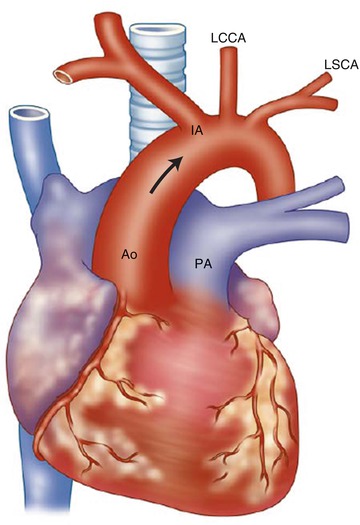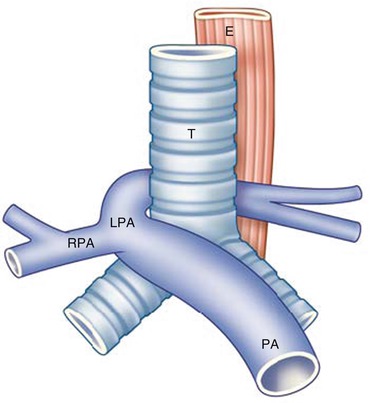Fig. 1
Double aortic arch. Esophagus and trachea are encircled by the dominant right (Right AA) and the hypoplastic left (Left AA) aortic arches. The left subclavian (LSCA) and common carotid artery (LCCA) originate from the left aortic arch. The right common carotid (RCCA) and subclavian (RSCA) arteries originate from the dominant right aortic arch. Ao aorta, PA pulmonary artery, AA ascending aorta (Source: Dr. Anastasios Polimenakos)
1.
Among the most common forms of vascular rings.
2.
Occurs when the left or right fourth fetal aortic arch fails to regress during fetal development.
3.
In 75 % the right aortic arch is the dominant, in 20 % the left and in 5 % both.
4.
Usually an isolated cardiac anomaly rarely (<1 %) associated with other congenital cardiac defects such as Tetralogy of Fallot (TOF) or atrioventricular septal defects.
5.
The Kommerell’s diverticulum represents an important component of a vascular ring (associated with the descending thoracic aorta and the ligamentum arteriosum) that need to be resected during the repair to prevent recurrence of compressing symptoms to the adjacent structures.
6.
Associated extracardiac malformations such as cerebral, oropharyngeal or genitourinary are rarely present but need to be considered during the diagnostic work-up.
(ii)
Right aortic arch with aberrant left retroesophageal subclavian artery and left-sided ligamentum arteriosum.
1.
Second most common complete vascular ring.
2.
Almost always presents as an isolated cardiac anomaly.
(iii)
Right aortic arch with mirror-image branching, left-sided ligamentum arteriosum (coming off the descending thoracic aorta) and Kommerell’s diverticulum. In 10–15 % is associated with other congenital cardiac defects such as TOF (in 25 % of TOF), truncus arteriosus (in 30 % of truncus arteriosus), or atrioventricular septal defects.
(iv)
Left aortic arch with mirror-image branching and right descending thoracic aorta (rare).
(v)
Left aortic arch with right descending thoracic aorta and right-sided ligamentum arteriosum (rare).
(b)
Incomplete vascular rings: form an incomplete encirclement of the trachea and/or esophagus with/or without compression. These include:
(i)
Anomalous origin of the innominate artery. Anterior compression of the trachea can be developed if the takeoff from the aorta is more posterior or to the left.


Fig. 2
Anomalous origin of the innominate artery. The arrow shows the abnormal posterior and lateral origin of the innominate artery (IA) with anterior compression of the trachea. (Ao aorta, LCCA left common carotid artery, LSCA left subclavian artery, PA pulmonary artery) (Source: Dr. Anastasios Polimenakos)
(ii)
Aberrant right retroesophageal subclavian artery.
1.
Occurs in 0.5 % of general population but it is often underdiagnosed due to absence of symptoms.
2.
Commonly encountered as incidental finding.
3.
Often associated with coarctation of the aorta.
(iii)
Right aortic arch with mirror-image branching and left ligamentum arteriosum (coming off the innominate artery instead of the descending thoracic aorta).
(iv)
Pulmonary artery sling.


Fig. 3
Pulmonary artery sling. The left pulmonary artery (LPA) originates from the right pulmonary artery (RPA) and travels between the trachea (T) and the esophagus (E) (PA pulmonary artery) (Source: Dr. Anastasios Polimenakos)
1.
Left arises from the right pulmonary artery instead of the main pulmonary artery; courses behind the trachea and in front of the esophagus which causes the compression.
2.
Often associated with tracheal stenosis (up to 50 %, “ring-sling complex”) with formation of complete cartilaginous rings; tracheomalacia is commonly present.
3.
Clinical presentation:
(a)
Get Clinical Tree app for offline access

General Manifestations:
(i)
Vascular rings may remain asymptomatic for life.
(ii)




75 % demonstrate early symptoms within the first month of life.
Stay updated, free articles. Join our Telegram channel

Full access? Get Clinical Tree


